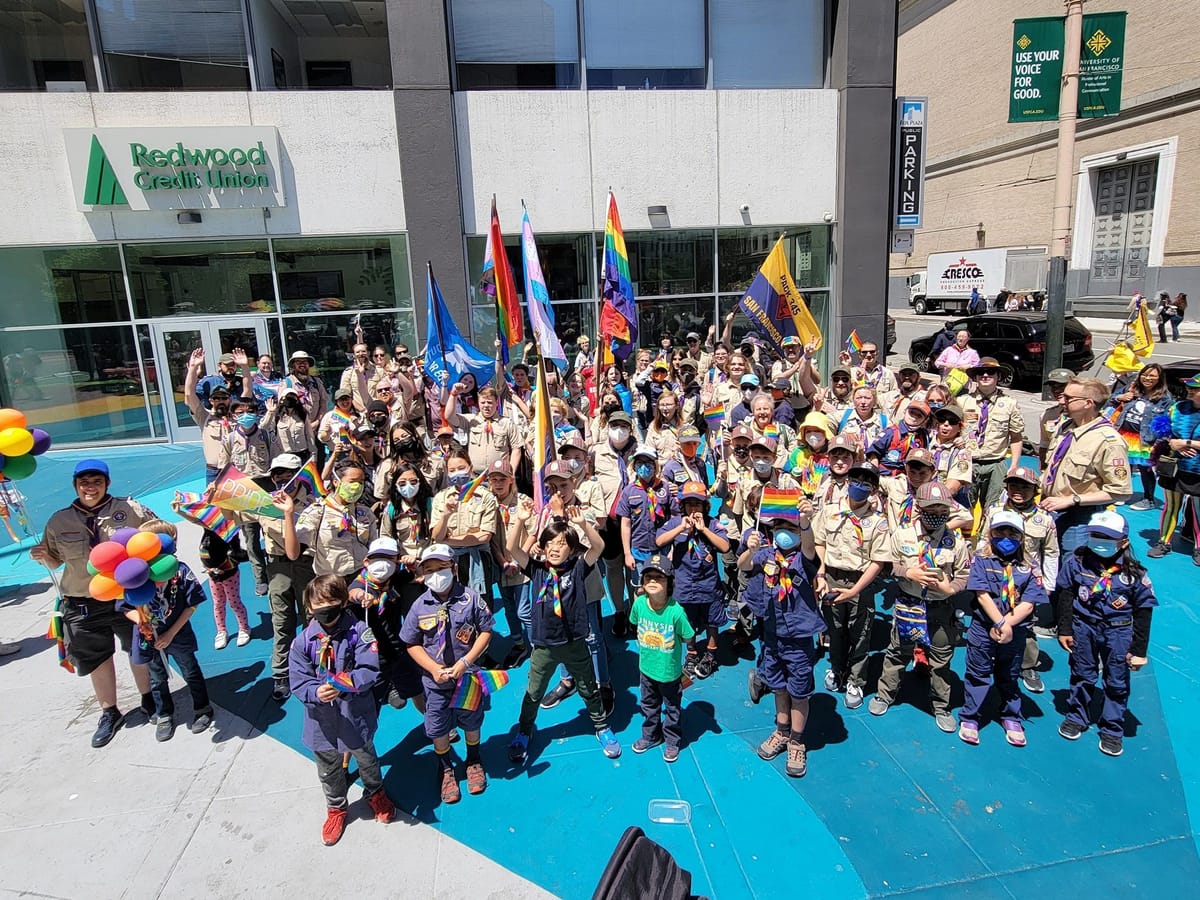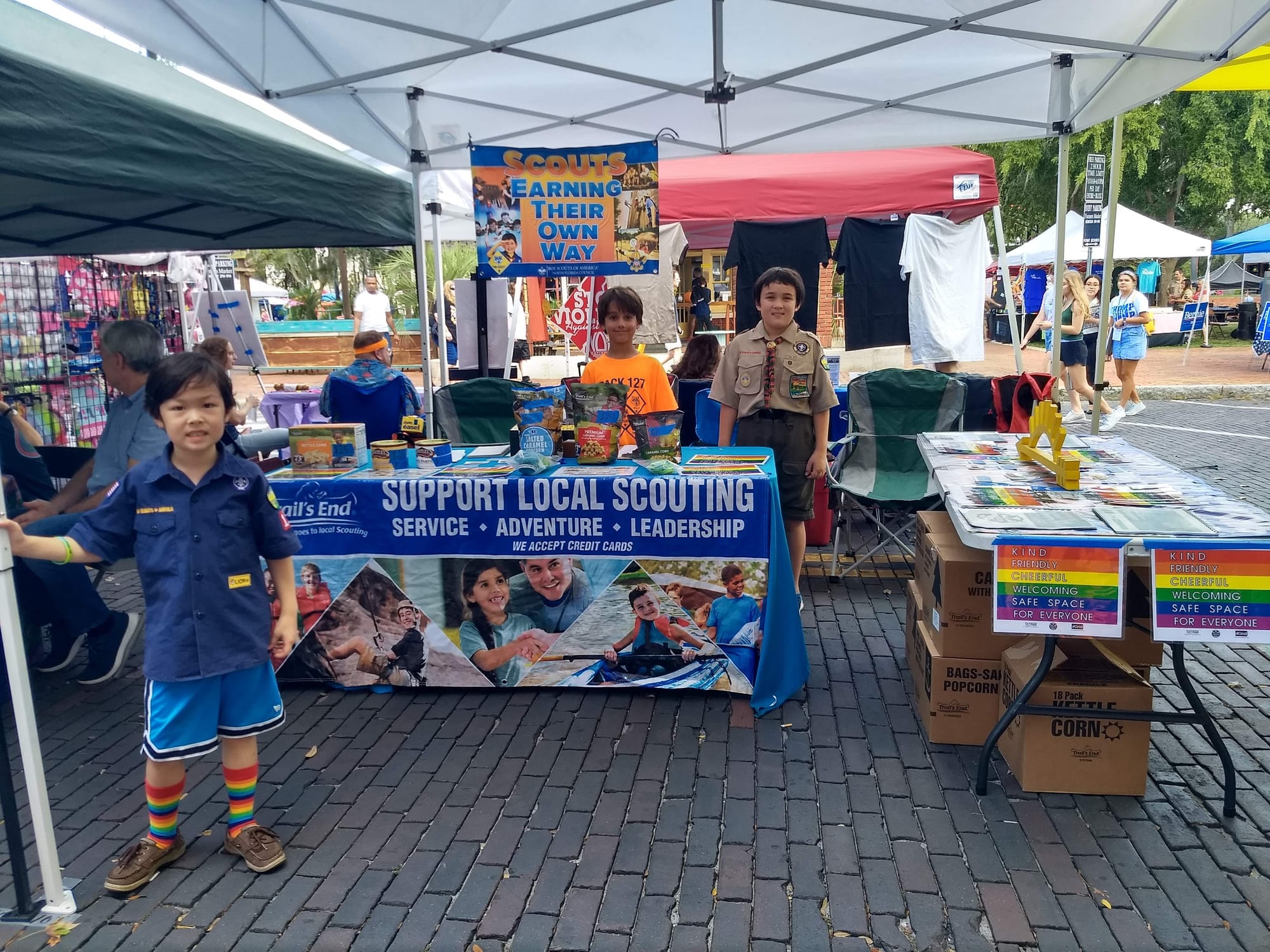Your guide to marching at Pride
Showing up to Pride as a Scouter can be a great way to support LGBTQ+ Scouts, and cast a wider net for membership growth.

If you're interested in taking your Scout troop to an LGBTQ+ Pride event this June, now is a good time to start planning.
Whether you want to march in a parade, table on the sidelines, or just witness the event, there's many different ways to incorporate Pride into your Scouting calendar.
Here are three examples of Scouting units participating in Pride, and their advice on how you can do it, too.
Wendell Baker has been marching in Pride parades for the better part of a decade.
His first time was in 2013, when he marched in San Francisco Pride with a contingent organized by Scouts for Equality. Back then, it was a very small group, and a very controversial thing to do, as the BSA was still in the heat of the gay membership battle. Baker and his fellow marchers didn’t wear uniforms, for example, careful to avoid any blowback for breaking BSA rules.
But the crowds loved seeing SFE in the parade, and the experience got Baker interested in going back. Every year since, as long as there’s been a parade, he’s marched with a Scouting contingent.
"It’s changed quite a bit," Baker told me last year. In the early days, the contingent hovered around 50 people. By 2022, in a group that combined a Cub Scout pack as well as Scouters from around the council, there were more than 150 people—all in uniform.
"This thing just took off. And a lot of them were Cub Scouts," Baker said.
While the Cub pack’s participation in 2022 was supported by the council, and promoted in district newsletters, Baker’s contingent was technically registered under SFE Golden Gate—a separate entity that was once a chapter of the now-defunct national organization, Scouts for Equality.
Baker treats the event as a more of a regional thing, anyway. He invites anyone and everyone who supports Scouting: Members of the BSA, members of the Girl Scouts of the USA, or plain old allies. Most people who show up are registered Scouters, Scouts and their parents.
"It’s family friendly, it’s a good thing for people to come to," Baker said. Cub Scouts were required to come with a parent, and in most cases it is the parents who decide whether to attend and bring their kids.
But everyone, regardless of age, absolutely loves the experience: walking through the city, huge crowds cheering on the sidelines and joy bursting from every corner.
"The younger kids all seem to have a good time," Baker said. "The older kids, it seems to be an event where they’re like, 'This is fabulous, this is important.' They're just kind of glowing afterwards."
These days, no one has much of a hesitation about being in uniform, Baker tells me. The Scouts carry the American flag, state flag and troop or pack flags, right alongside Pride flags. Some even wear rainbow epaulets.

‘Nobody could show me where it says we can’t’
Not everyone has, or needs, the decade of experience that Baker brings to Pride marches. Paige Lawson, a volunteer in Kansas City who leads a Scouts BSA troop, marched in Pride with her unit for the first time in 2022.
Lawson's troop is something of a refuge for LGBTQ+ Scouts, Scouts struggling with mental health, or Scouts who otherwise don’t fit in elsewhere, she says.
When Lawson first considered bringing her unit of about 15 Scouts to Pride, people told her she couldn’t do it, that she would get kicked out of the BSA if she did. But she figured, if scouts are allowed to do color guard at other political events, why not at Pride?
"I didn't see why we’d have to ask permission to do something we’re allowed to do," Lawson told me last year. "Nobody could show me where it says we can’t."
So she reached out to the organizers of Kansas City Pride and offered her troop as the official color guard. The event organizers liked the idea, and so did the kids in Lawson’s troop.
About two weeks before the parade, Lawson received the harnesses and flags they’d be using, and brought the contingent together to practice carrying, walking and etiquette with the flags. The Scouts had it down in under a half hour.
It was totally voluntary—Scouts weren’t required to participate—but many of them did. The troop marched at the front of the parade carrying the flags, and proudly wearing their uniforms. Those who weren’t charged with the colors handed out flyers, advertising the troop and outlining the BSA’s recent inclusion milestones.
"They all seemed to really enjoy it. They got a lot of cheers. They got to yell back and forth with the people watching, so they were excited about it. It’s good for them to have people cheering for them," Lawson said.

Popcorn at Pride
Mike Ryan Simonovich is another lifelong Scouter who is no stranger to Pride events.
His first experience, like Baker’s, was with a Scouts for Equality contingent, but in Gainesville, Florida. It was small, too, just a couple of families. Ryan Simonovich wore a uniform and rainbow epaulets, his kid wore a Cub Scout uniform, and they held an SFE banner as they marched along.
It did not go over well. A member of Ryan Simonovich’s pack reported them to a district executive, which led to a meeting with council leadership. He was told not to march in uniform, not to wear the rainbow loops, and not to do it again without permission.
The next time Ryan Simonovich made an attempt at participating in Pride was in 2017, with his son’s Cub Scout pack. This time, the Cubmaster went to the district executive for explicit permission—not to march, but to set up a table at Pride. They pitched it as an opportunity to promote the membership of girls in Scouting, and to sell some popcorn.
"Officially what we were doing was selling popcorn at Pride," Ryan Simonovich told me last year. But the unit did get permission to do so, and ran with it.
The pack’s table at Pride did sell popcorn, sure, but also served to show that Scouting was supportive of LGBTQ+ inclusion. Everyone wore a uniform, some adorned with rainbow knots or loops, and there may have been some Pride flags that snuck in too.
"We were there so that people would see that there are inclusive Scouts," Ryan Simonovich said. The response was overwhelmingly positive.
"People were so excited," he said. They didn’t receive a single negative comment. "It was all people who were like, 'Wow, this is not what I thought I would see' … That was mission-accomplished right there."
Going forward, Ryan Simonovich said he’s leaving decisions about participating in Pride up to the youth in his son’s troop. One Scout already tried to organize a contingent, but the parade conflicted with the troop’s camping schedule. There’s enough interest, however, to start building Pride right into the troop’s annual calendar.
Have you participated in Pride with your Scouting unit? What was the experience like? Let us know in the comments!



